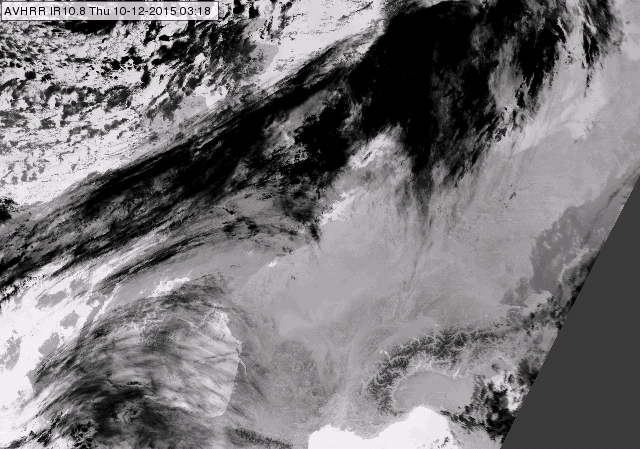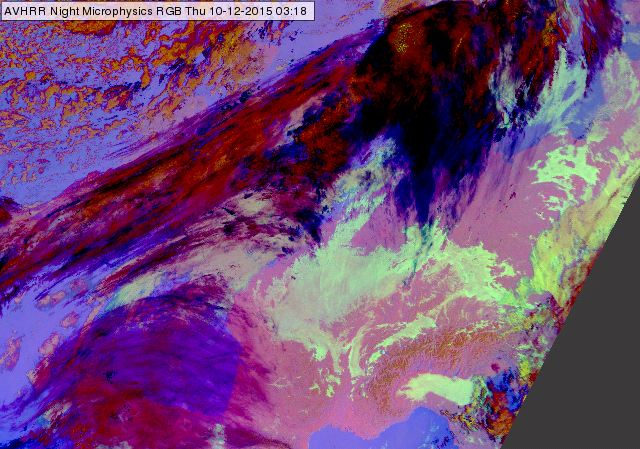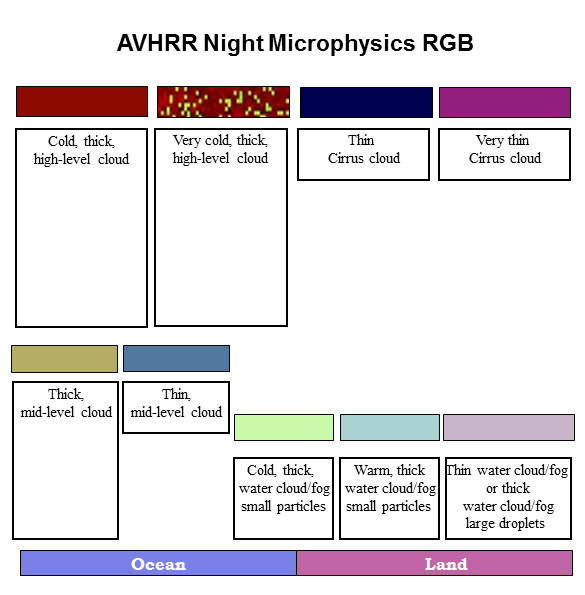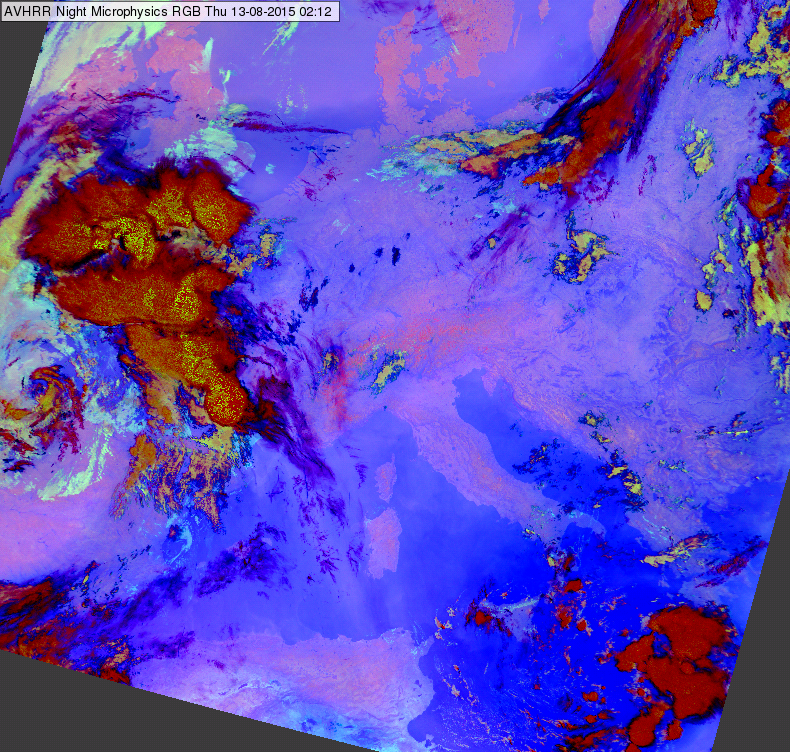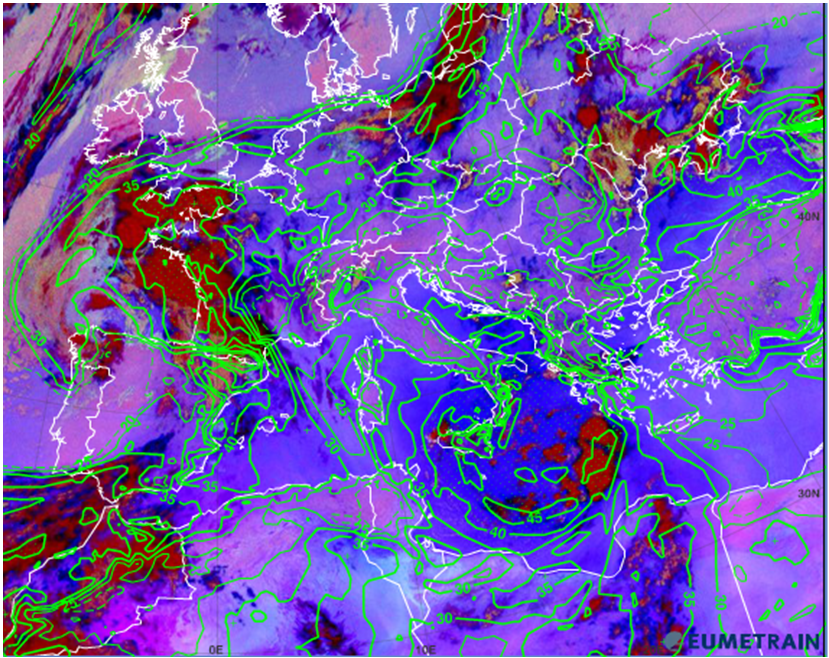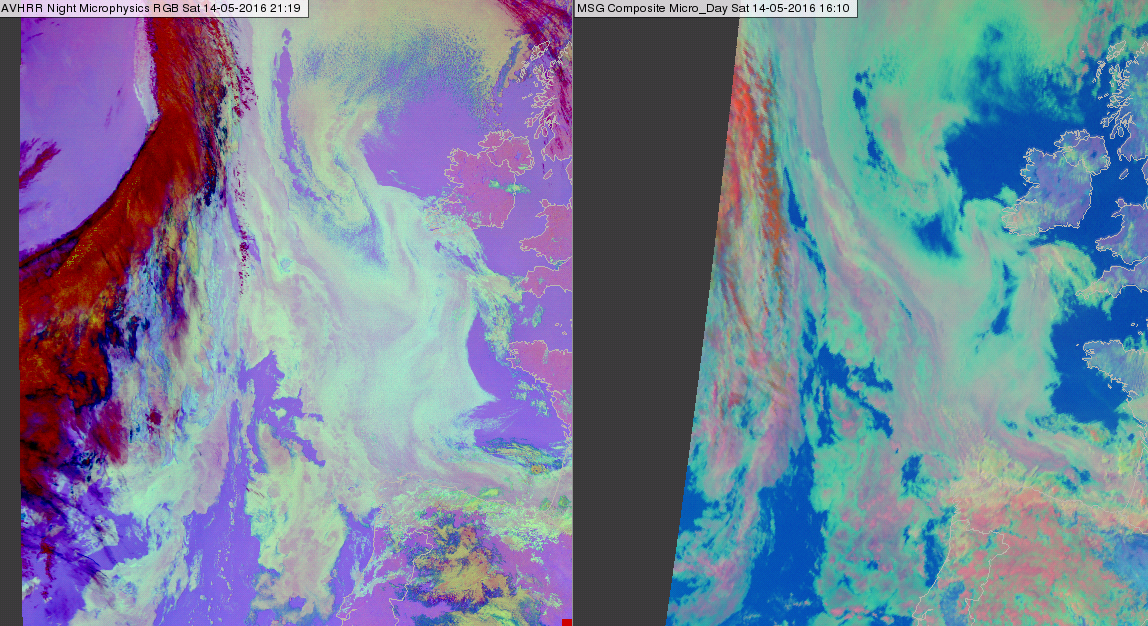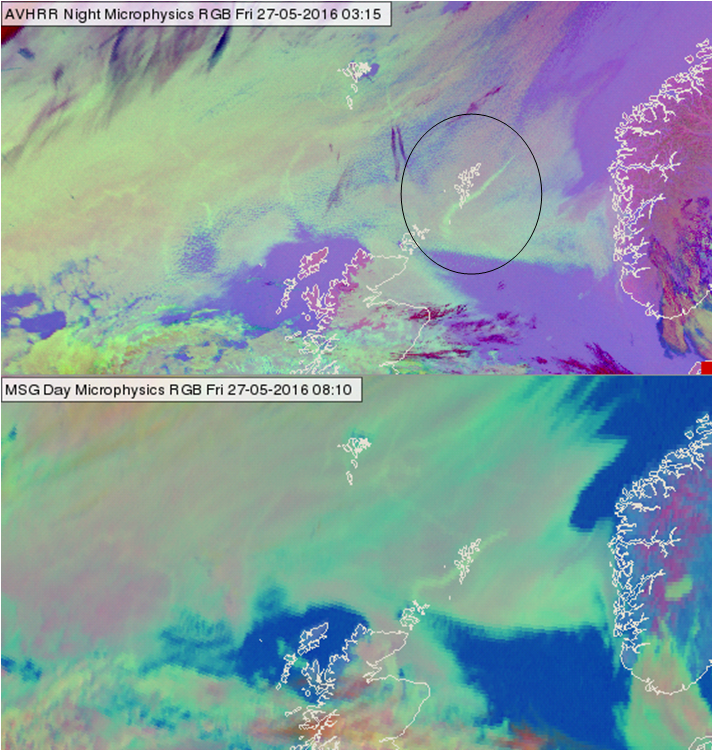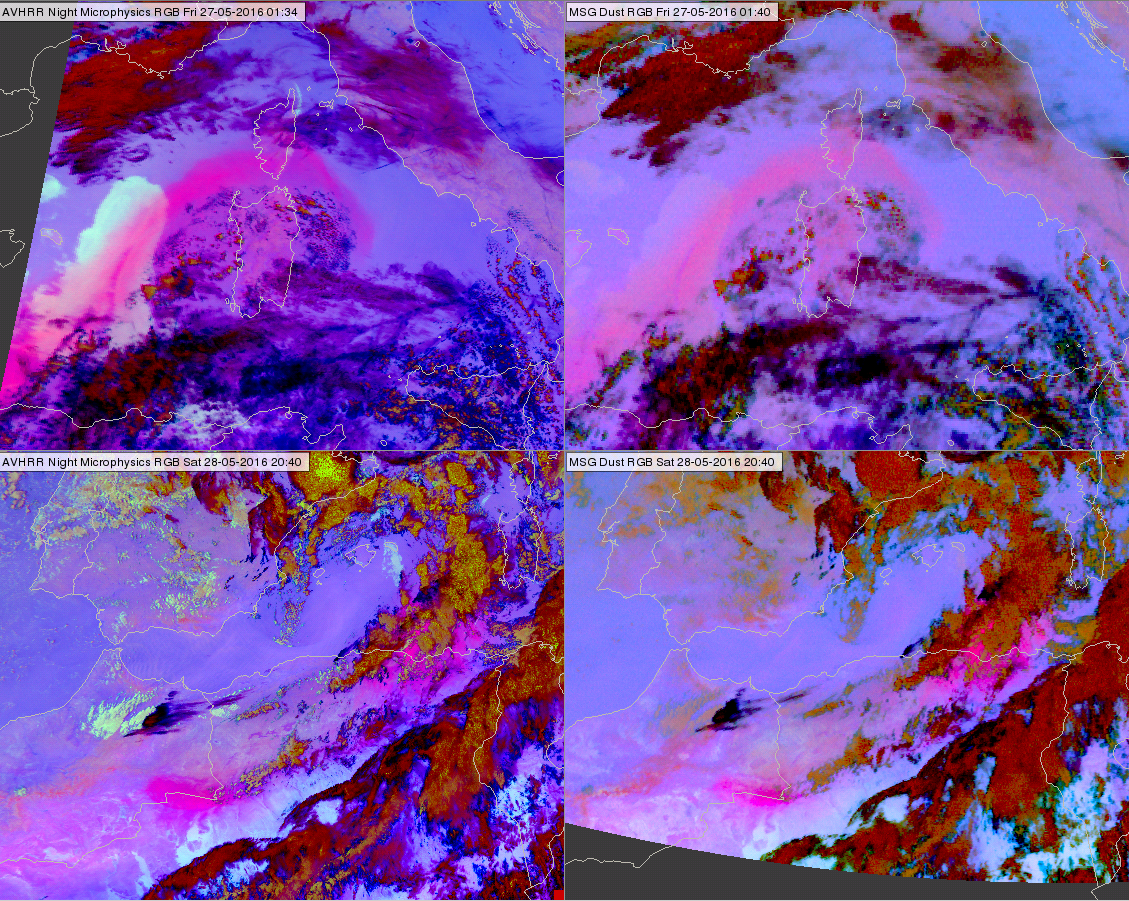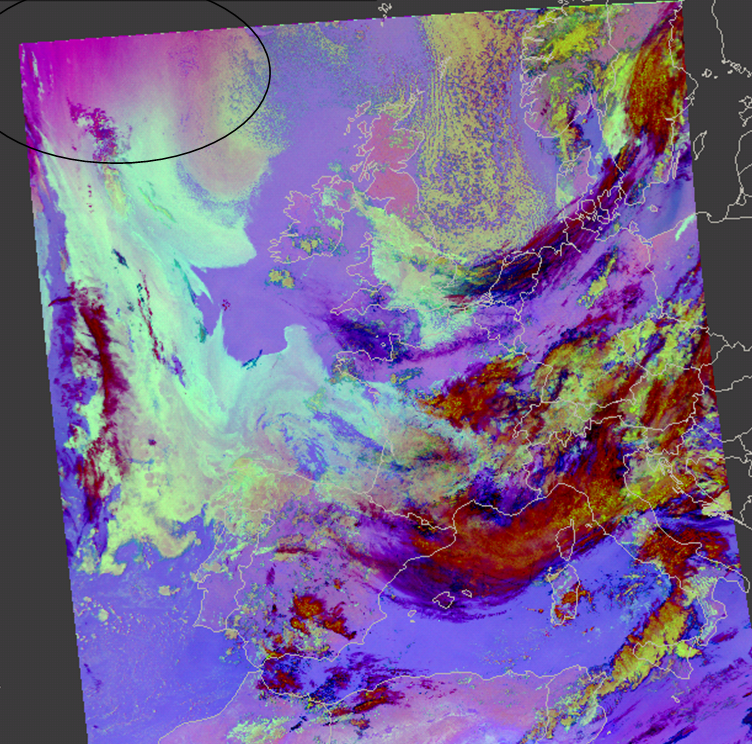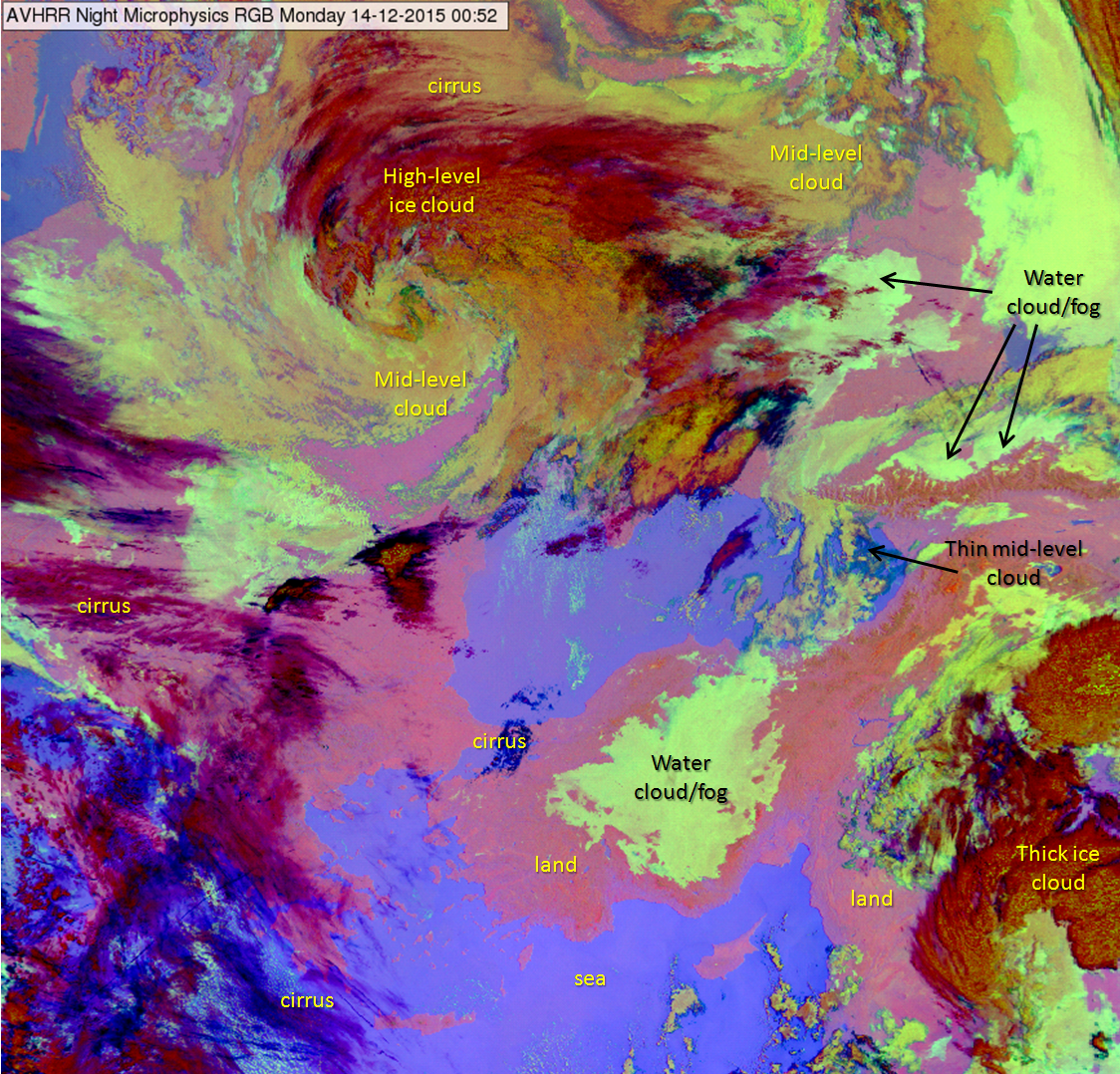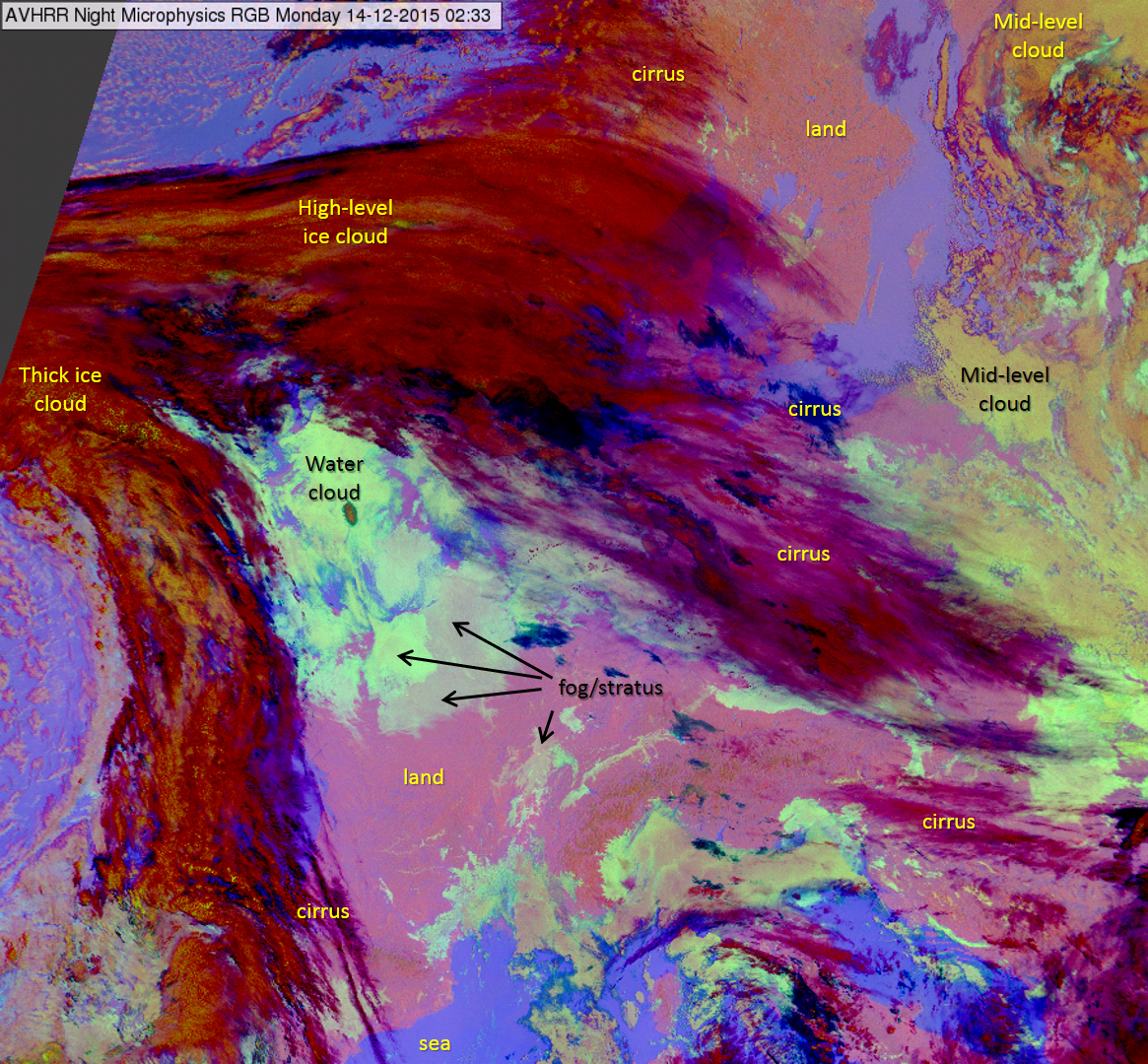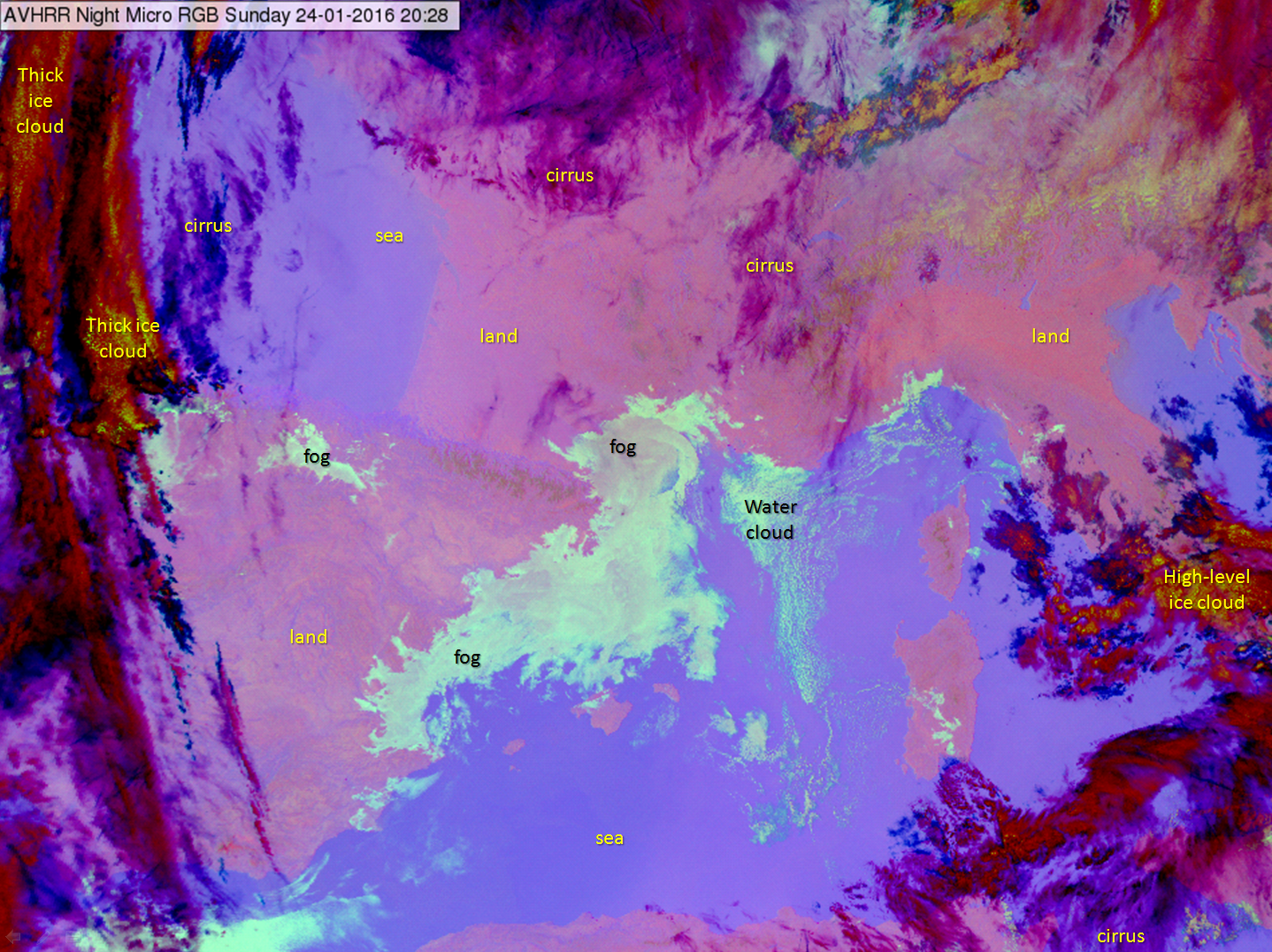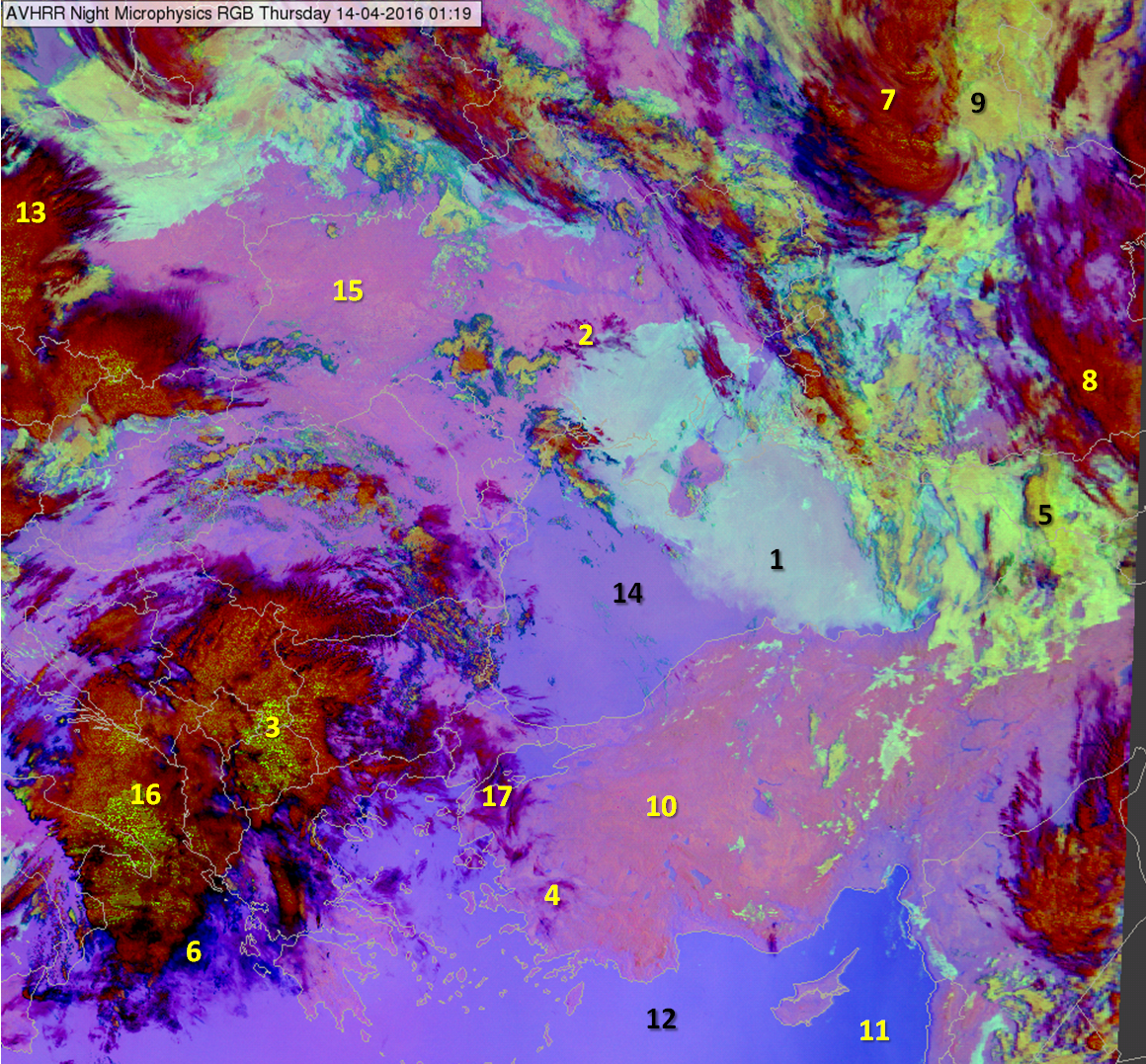Chapter II: AVHRR Night Microphysics RGB
Table of Contents
Aim
The Night Microphysics RGB images are created by combining data from the 12.0, 10.8 and 3.74 micrometer channels (noted by IR12.0, IR10.8 and IR3.74). Brightness temperature differences (BTD) are displayed in red and green, while the IR10.8 channel is shown in blue. As a nighttime RGB it uses only thermal infrared channels.
The main purpose of this RGB type is to distinguish fog and low clouds from cloud-free areas at night. This is very important for traffic security. Fog or stratus usually forms at night by radiation cooling, and since in-situ observations are rare, satellite information is vital.
Although the main goal is the detection of fog and low clouds, the Night Microphysics RGB also reveals other types of clouds. These RGB images contain information on cloud top temperature, cloud optical thickness and cloud top phase. Cloud-free areas contain information on low-level moisture and surface temperature. The color contrast between low and mid-level clouds, thin high level clouds and cloud-free areas is good.
Note that the IR3.74 brightness temperature field is rather noisy in very cold regions. IR3.74 data is not useful for determining the temperature of very cold features like thunderstorm tops. Therefore, the Night Microphysics RGB is not recommended for analyzing nighttime convection. The IR10.8 single channel is more appropriate for this purpose.
Note that the Night Microphysics RGB can be created from NOAA AVHRR data as well. Using the same recipe (see Table 1 in the section 'How to create Night Microphysics RGB images') it will have almost the same appearance.
Physical Basis
Which channels are useful for nighttime fog or low cloud detection?
At night only infrared (IR) channel data is available (IR10.8, IR12.0 and IR3.74). These are 'atmospheric window' channels where the absorption of the gas molecules is low. For cloud-free surfaces and opaque clouds, signal measurement in the atmospheric window channels depends mainly on the temperature of the measured object (sea, land, cloud top). The signal also depends on emissivity, as well as slightly on atmospheric effects. For semi-transparent clouds the interpretation of the measured radiation is more complicated.
The 'traditional' IR10.8 channel is included in the Night Microphysics RGB because it distinguishes thick clouds by their cloud top temperatures. However, for our purposes one channel is not enough.
Using only one IR channel makes the detection of two cloud types problematic:
- It is difficult (or impossible) to separate fog or low water clouds from a surrounding cloud-free surface because their temperatures are close to each other.
- It is difficult (or impossible) to separate semi-transparent clouds from opaque clouds.
These problems can be solved by analyzing the following brightness temperature differences:
- The (IR10.8-IR3.74) difference helps to distinguish water clouds (fogs) from cloud-free areas.
- The (IR12.0-IR10.8) difference helps to distinguish thick and thin clouds.
For that very reason these differences are used in the Night Microphysics RGB together with the IR10.8 channel.
Distinguishing between cloud-free surfaces and fog or water clouds
The (IR10.8-IR3.74) brightness temperature difference helps to distinguish water clouds (fogs) from cloud-free areas.
The technique is based on two facts:
- The emissivity values of water clouds and the surface are about the same in the IR10.8 channel. As a consequence, water clouds are hard to detect in IR10.8 images.
- The emissivity values of water clouds and the surface differ slightly in the IR3.74 channel. As a consequence, fog or stratus doesn't show up clearly in IR3.74 images either, though still a little better than in the IR10.8 channel.
The difference between water clouds and the surface will be more pronounced in the (IR10.8-IR3.74) difference image. The difference will be high for water clouds (or fog) and around zero for cloud-free surfaces.
Detection of semi-transparent cirrus clouds
Cirrus clouds consist of ice crystals and are often semi-transparent. In the case of thin clouds some of the radiation coming from below goes through and so the radiation reaching the satellite is called 'mixed radiation': the brightness temperature is usually higher than the real temperature of the cirrus clouds. The brightness temperature of a semi-transparent cloud depends primarily on its real temperature, its transparency and the temperature of the underlying surface.
For semi-transparent clouds the brightness temperature difference of two channels depends strongly on differences in transmissivity. The transparency of thin ice clouds is considerably different around 3.74, 10.8 and 12.0 micrometers, as the ice's absorption is rather different at these wavelengths (see the arrows in Fig. 1a). Thin cirrus clouds can be detected by the (IR12.0-IR10.8) and (IR10.8-IR3.74) differences (large negative differences). The absorption is weaker in the IR10.8 channel than in the IR12.0 channel, which means the IR10.8 transmissivity will be higher and as a consequence the (IR12.0-IR10.8) brightness temperature difference will be negative.
Figure 1a: Absorption spectra of water (blue curve) and ice (orange curve)
(Source: MSG Interpretation Guide, EUMETSAT)
Fig. 1b shows simulated (11-12 microns) brightness temperature difference (BTD) values as a function of 11 micron brightness temperature (BT) for different types of cirrus clouds. The black numbers along the curves refer to the cloud optical thickness. The figure shows that:
- The BTD values of opaque cirrus clouds are close to zero (left node of the curves).
- The BTD values of almost totally transparent and extremely thin cirrus clouds are also close to zero (right node of the curves).
- For medium thick semi-transparent cirrus clouds the 11 and 12 micron BTs differ considerably.
This is the difference which makes it possible to distinguish opaque and (not too thin) semi-transparent ice clouds.
Figure 1b:Simulated BTD (11-12 microns) as a function of 11 micron BT for different types of cirrus clouds. The numbers refer to optical thickness
(Source: P. Menzel, NOAA NESDIS, Univ. of Wisconsin)
How to create Night Microphysics RGB images
EUMETSAT's recommendation for Microphysics RGBs is that the cloud thickness information should be visualized in red, the microphysical information in green, and the temperature information in blue.
The 'recipe' of the Night Microphysics RGB type is summarized in Table 1. It shows which channels correspond to which color. The measured values should be calibrated to brightness temperatures. The images should be then enhanced - linearly stretched - within the ranges shown in the table.
| AVHRR Night Microphysics RGB | ||||
|---|---|---|---|---|
| Color | Channel | Range | ||
| Red | IR12.0 - IR10.8 | -4 | +2 | K |
| Green | IR10.8 - IR3.74 | -4 | +6 | K |
| Blue | IR10.8 | 243 | 293 | K |
Table 2:Recipe of the AVHRR Night Microphysics RGB scheme
The following example shows how the Night Microphysics RGB is combined from IR3.74, IR10.8 and IR12.0 images. Both the resulting RGB and its components are included.
Fig. 2a shows the three IR channels separately as single channels, all enhanced in the 243-293 K brightness temperature range. Usually the IR images are grayscale images in which bright shades are assigned to cold and dark shades to warm objects. However, in Fig. 2a the warm objects (surface, warm clouds) are bright and the cold clouds are dark. In Fig. 2a the Po Valley and several other areas are covered by fog or low clouds. This fog is not (or barely) visible in the IR10.8 and IR12.0 images. In the IR3.74 image one might suspect its presence. As mentioned before, the transparency of cirrus clouds is dependent on wavelength; see for example the thin cirrus clouds over the ocean west of France. They are the least dark (the most transparent) in the IR3.74 image.
Figure 2a: AVHRR IR3.74 (top), IR10.8 (middle) and IR12.0 (bottom) images of western Europe on 10 December 2015 at 03:18 UTC
Fig. 2b shows the color components of a Night Microphysics RGB image; that is, the channel (differences) found in the recipe with the corresponding enhancement. The lower left panel shows the Night Microphysics RGB.
- In the (IR12-IR10.8) difference image semi-transparent clouds in their dark shades are easily recognizable, while fog is not.
- In the (IR10.8-IR3.74) difference image the surface is medium grey, water clouds (fog) are much brighter, while thin ice clouds are dark. Foggy areas have excellent contrast against cloud-free areas.
Figure 2b: AVHRR (IR12.0-IR10.8) BTD (upper left), (IR10.8-IR3.74) BTD (upper right), Night Microphysics RGB (bottom left) and IR10.8 (bottom right) images of western Europe on 10 December 2015 at 03:18 UTC
Fig. 2c shows the same images as Fig. 2b except the three components are visualized in their respective colors instead of shades of gray. This is how the three components are visualized together in the RGB.
Figure 2c: AVHRR (IR12.0-IR10.8) BTD (upper left), (IR10.8-IR3.74) BTD (upper right), Night Microphysics RGB (bottom left) and IR10.8 (bottom right) images of western Europe on 10 December 2015 at 03:18 UTC
Fig. 2d shows the four panels of Fig. 2b on top of each other. Hover your mouse over the image to use the slider.
Figure 2d: 4-Panel display, please use your mouse to compare the four images. AVHRR (IR12.0-IR10.8), (IR10.8-IR3.74), IR10.8 and Night Microphysics RGB images of western Europe on 10 December 2015 at 03:18 UTC.
Typical colors
Fig. 3 shows the typical colors of Night Microphysics RGB images. These are just examples; actual images have much greater variation in their colors and tones. Note that the shade of the colors may vary across the swath. For more on this see the chapter 'Effects of the scanning geometry'.
- The colors of the clouds depend on cloud top temperature, cloud top phase and cloud optical thickness (transparency).
- The colors of the cloud-free surface depend on surface temperature and the (low-level) moisture content of the atmosphere.
Figure 3: Typical colors of the Night Microphysics RGB
The typical colors of clouds are as follows:
- Thick low-level water clouds (fogs) are light green. Warmer water clouds are depicted in bluer tones. If the water cloud consists of large droplets it is gray with a pinkish tone.
- Thin low-level water clouds (fogs) are gray with a pinkish tone.
- Thick mid-level clouds appear (greenish) tan.
- Thin mid-level clouds appear greenish or bluish gray. The color of the very thin mid-level clouds approximates the color of the underlying surface.
- Thick ice clouds are red-brown. However, green dots often appear on the top of a thick and very cold ice cloud (see the high clouds in Fig. 5a). These 'noisy pixels' have colors similar to thick water clouds, but it is important to remember that a cold, thick cloud top with green dots means it is very cold, not that there are warm water clouds in some pixels! (The explanation for this feature is that for very cold, thick clouds the measured radiation is almost zero in the IR3.74 channel, and the retrieved brightness temperature is noisy.)
- Medium thin semi-transparent ice clouds are dark blue.
- The color of very thin cirrus clouds approximates the color of the underlying surface (e.g. dark pink over land). Note that their color depends on their height as well. VERY high and VERY thin clouds can also be black.
- Dust clouds appear pink.
The typical colors of cloud-free surfaces are as follows:
The typical colors of cloud-free surfaces depend on surface temperature and the moisture (particularly on low-level moisture) content of the atmosphere.
The color is usually determined by temperature. At night, the sea is usually warmer than the land, so
- the sea usually appears bluish, while
- (non-deserted) land usually appears pinkish.
However, the color of a cloud-free surface depends not only on the surface temperature, but on atmospheric (low-level) moisture content as well:
- moist areas appear more bluish, while
- dry areas appear more pinkish.
In cloud-free regions both the (IR12-IR10.8) and the (IR10.8-IR3.74) differences depend on atmospheric moisture content. A cloud-free atmosphere is more transparent around 3.74 μm than around 10.8 μm, and more transparent around 10.8 μm than around 12.0 μm, as shown in Fig. 4. If the moisture content is higher, the red and the green components of the surface will be lower, so the mixed color will appear more bluish.
Figure 4: Atmospheric transmission spectra
(Source: http://www.photonics.com/EDU/Handbook.aspx?AID=25132)
Fig. 5 shows an example where the effects of moisture content are clear in the Night Microphysics RGB image. The structure of bluish and pinkish tones over the Mediterranean, the North Sea and the Baltic Sea reflect the effects of atmospheric moisture. For example, the sharp boundary between the pinkish and bluish cloud-free areas over the North Sea is a moisture boundary.
Figure 5a: AVHRR Night Microphysics RGB for 13 August 2015 at 02:12 UTC
Fig. 5b shows a METEOSAT SEVIRI Night Microphysics RGB image overlaid by ECMWF TPW (Total Precipitable Water in mm) analyses for the same day at 00 UTC. The ECMWF's TPW analysis fits the pinkish-bluish color scheme of the Night Microphysics RGB well. It confirms the moisture boundary across the UK and Denmark and the presence of an area of increased moisture southeast of Italy.
Figure 5b: SEVIRI Night Microphysics RGB image overlaid by ECMWF Total Precipitable Water analysis on 13 August 2015 at 00 UTC
(Source: e-port, EUMeTrain)
The Night Microphysics RGB contains information on the effective particle size of water clouds, because the IR3.74 emissivity is somewhat higher if the cloud top droplets are large. In that case the otherwise large green component becomes slightly weaker. An example is presented in the left panel of Fig. 6. For comparison, the right panel shows a SEVIRI Day Microphysics RGB from some hours earlier. The pinkish gray stripes in the greenish maritime water clouds (seen in left panel) consist of larger droplets. The similar structure of the same cloud in the SEVIRI Day Microphysics RGB confirms this.
Figure 6: AVHRR Night Microphysics RGB image (left) and SEVIRI Day Microphysics RGB image (right) on 14 May 2016 at 21:19 and 16:10 UTC
Ship tracks are another example. Ships inject a large amount of condensation nucleus into the atmosphere, so along their trails the water cloud consists of smaller droplets. The upper panel of Fig. 7 shows greenish ship tracks. For comparison, the bottom panel shows a SEVIRI Day Micro RGB some hours later.
Figure 7: AVHRR Night Microphysics RGB image (top) and SEVIRI Day Microphysics RGB image (bottom) for 27 May 2016 at 03:15 and 08:10 UTC
Figure 8: AVHRR Night Microphysics RGB images (left panels) and SEVIRI Dust RGB images (right panels) on 27 May 2016 at 01:34 and 01:40 UTC (upper panels) and 28 May 2016 at 20:40 UTC (bottom panels)
Fig. 8 presents AVHRR Night Microphysics RGB images together with the temporally most closely matching SEVIRI Dust RGB images available. In the Dust RGB the pink color indicates thin dust clouds. The thin dust clouds are also seen in the AVHRR Night Microphysics RGB, and are also shown in pink. This is because the (IR12-IR10.8) brightness temperature difference (BTD) values are high for thin dust clouds. This BTD is the key channel combination for dust detection, and it comprises the red component in both RGBs.
Note that all colors discussed above refer to nighttime. If some part of the image is already/still sunlit the cloud appears magenta, such as in the top left part of Fig. 9.
Figure 9: AVHRR Night Microphysics RGB image on 13 May 2016 at 20:52 UTC
Examples of interpretation
Three cases are shown with annotations to demonstrate the proper interpretation of different surface and cloud types in Night Microphysics RGB images (Figs. 10 - 12).
Figure 10: AVHRR Night Microphysics RGB on 14 December 2015 at 00:52 UTC
Figure 11: AVHRR Night Microphysics RGB on 14 December 2015 at 02:33 UTC
Note that thick fog/low level clouds (stratus) appear green in the case of small water droplets or gray with a pinkish tone in the case of large droplets. Thin fog and stratus also appear gray with a pink tone.
Figure 12: AVHRR Night Microphysics RGB on 24 January 2016 at 20:28 UTC
Benefits and limitations
The benefits of the Night Microphysics RGB:
- Provides full cloud analysis at night.
- Detects fog and low-level water clouds (with good color contrast).
Limitations:
- The IR3.74 brightness temperature values of high and very cold clouds are often noisy, resulting in green dots in the reddish-brown ice clouds. Therefore this RGB is not recommended for nighttime convection analysis. The IR10.8 single channel is more appropriate for this purpose.
- Extremely thin water cloud or fog might not be detected by the Night Microphysics RGB.
- Night Microphysics RGB might not detect all water clouds (or fog) at twilight, because then the IR3.74 channel also contains some solar radiation.
Comparison of AVHRR and SEVIRI Night Microphysics RGB images
Table 2 shows the recipes of the AVHRR Night Microphysics RGB and EUMETSAT's recommended standard SEVIRI Night Microphysics RGB scheme. The recipes only differ in their green components. The central wavelengths of the AVHRR IR3.74 and SEVIRI IR3.9 channels are 'shifted'. The ranges of the green component are different due to differences in CO2 absorption in the IR3.74 and IR3.9 channels.
| AVHRR Night Microphysics RGB | ||||
|---|---|---|---|---|
| Color beam | Channel | Range | ||
| Red | IR12.0 - IR10.8 | -4 | +2 | K |
| Green | IR10.8 - IR3.74 | -4 | +6 | K |
| Blue | IR10.8 | 243 | 293 | K |
| SEVIRI Night Microphysics RGB | ||||
|---|---|---|---|---|
| Color beam | Channel | Range | ||
| Red | IR12.0 - IR10.8 | -4 | +2 | K |
| Green | IR10.8 - IR3.9 | 0 | +10 | K |
| Blue | IR10.8 | 243 | 293 | K |
Table 3: Recipes of the AVHRR and SEVIRI Night Microphysics RGB schemes, with the difference highlighted in yellow
Figs. 13 and 14 show both the AVHRR and the most closely coinciding SEVIRI Night Microphysics RGB images. The images have mostly similar colors, though the AVHRR has better color contrast between water clouds and the surface. Both RGBs reflect the effects of atmospheric moisture content. Fig. 13 displays it quite well; there is a potential mistral event where winds push dry air over the Mediterranean.
As already mentioned, noise in the IR3.74, IR3.9 brightness temperature fields can cause the appearance of green dots among the reddish brown colors of high, very cold clouds. This noise is stronger in the AVHRR Night Microphysics RGB than in the SEVIRI one, see for example Fig. 13.
Figure 13: AVHRR and SEVIRI Night Microphysics RGB images on 3 September 2014, 20:40 UTC
Fig. 14 shows a 3-panel image with an AVHRR Night Microphysics RGB, a MSG SEVIRI Night Microphysics RGB and a MSG SEVIRI WV7.3 image. The WV7.3 image shows the high moisture content region.
Figure 14: NOAA-19 AVHRR Night Microphysics RGB (left), MSG SEVIRI Night Microphysics RGB (middle) and MSG SEVIRI WV7.3 channel image (right) on 12 April 2016 at 01:41 and 01:40 UTC
Exercises
Exercise 1
Which of the following features are present in the numbered areas in Fig. 15? Assign each number to only one feature.
| 1 | 2 | 3 | 4 | 5 | 6 | 7 | 8 | 9 | 10 | 11 | 12 | 13 | 14 | 15 | 16 | 17 | |
| Valley fog | + | + | + | ||||||||||||||
| Extended water cloud or fog, no cirrus above | + | ||||||||||||||||
| Water cloud or fog below cirrus | + | + | + | ||||||||||||||
| Thick mid-level cloud | + | ||||||||||||||||
| Thin mid-level cloud | + | ||||||||||||||||
| Thick ice cloud | + | + | |||||||||||||||
| Cirrus (over land) | + | + | + | ||||||||||||||
| Cirrus (terrain beneath not visible) | + | ||||||||||||||||
| Sea | + | ||||||||||||||||
| Land | + |
Figure 15: AVHRR Night Microphysics RGB image on 10 December 2015 at 20:04 UTC
Exercise 2
Which of the following features are present in the numbered areas in Fig. 16? Assign each number to only one feature.
| 1 | 2 | 3 | 4 | 5 | 6 | 7 | 8 | 9 | 10 | 11 | 12 | 13 | 14 | 15 | 16 | 17 | |
| Water cloud or fog | + | ||||||||||||||||
| Thick mid-level cloud | + | + | |||||||||||||||
| Thick ice cloud | + | + | + | + | + | ||||||||||||
| Cirrus | + | + | + | + | |||||||||||||
| Land | + | + | |||||||||||||||
| Sea (with a lot of atmospheric moisture) | + | ||||||||||||||||
| Sea (without much atmospheric moisture) | + | + |
Figure 15: NOAA-19 AVHRR Night Microphysics RGB on 14 April 2016 at 01:19 UTC
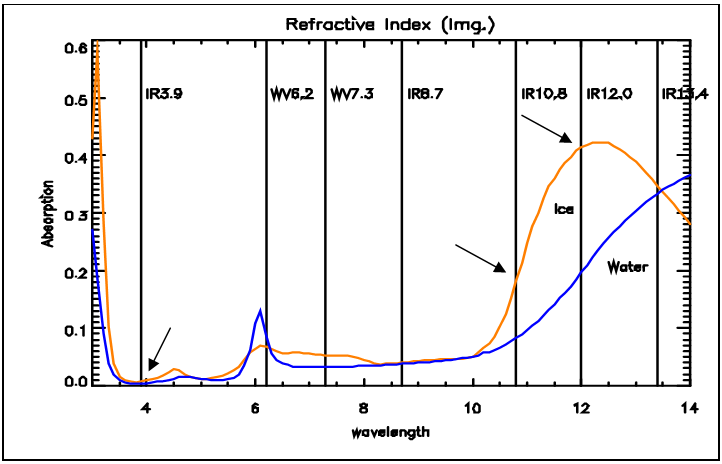
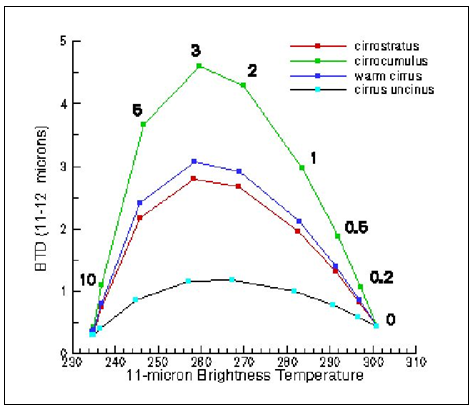
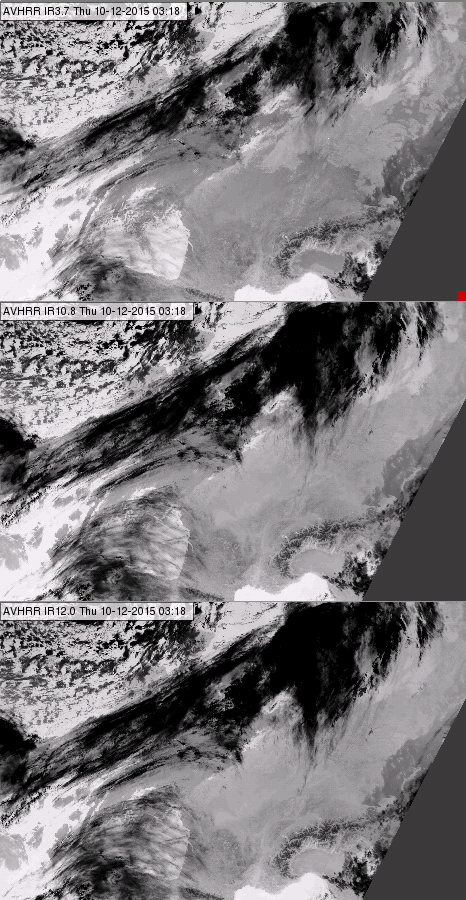
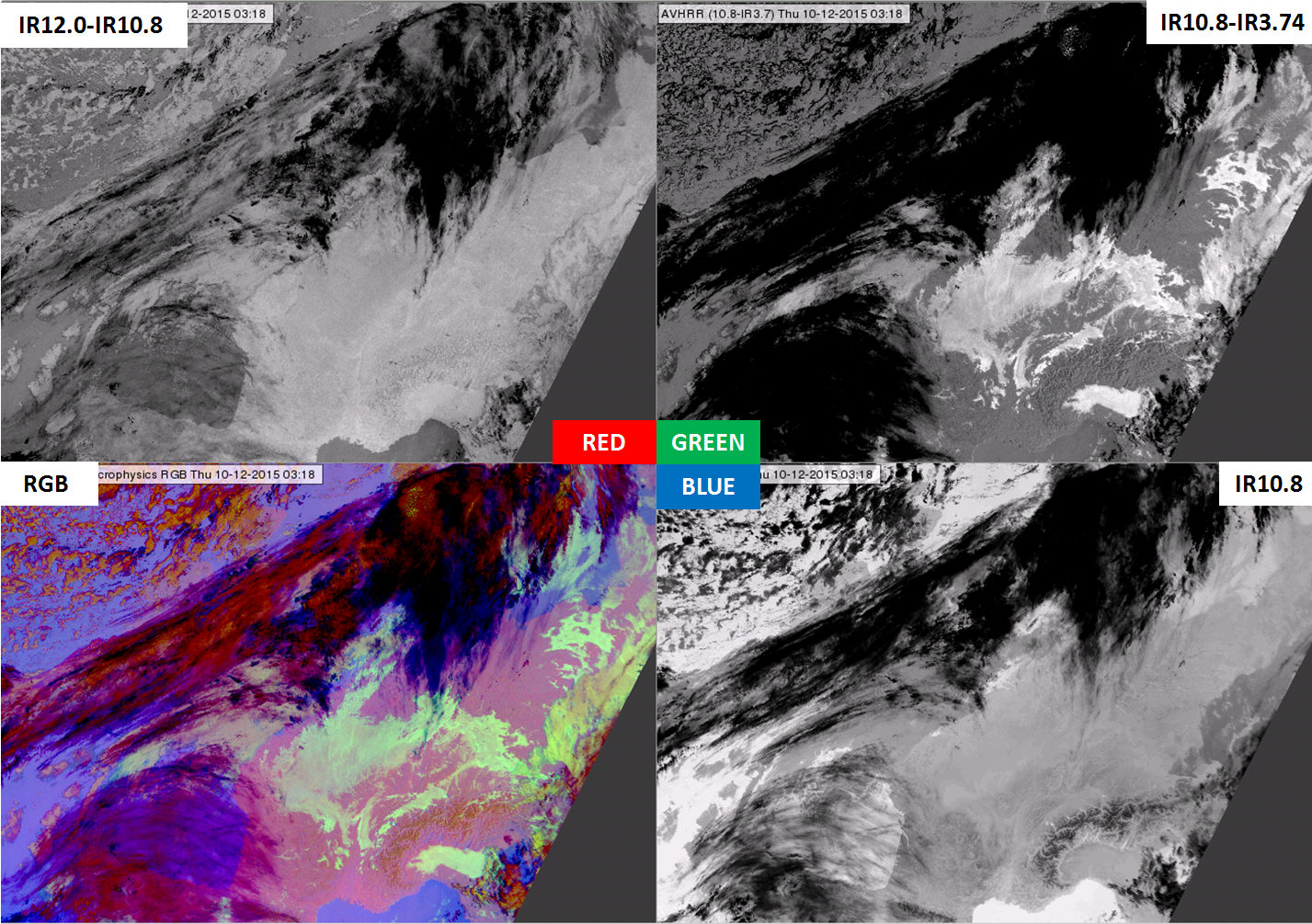
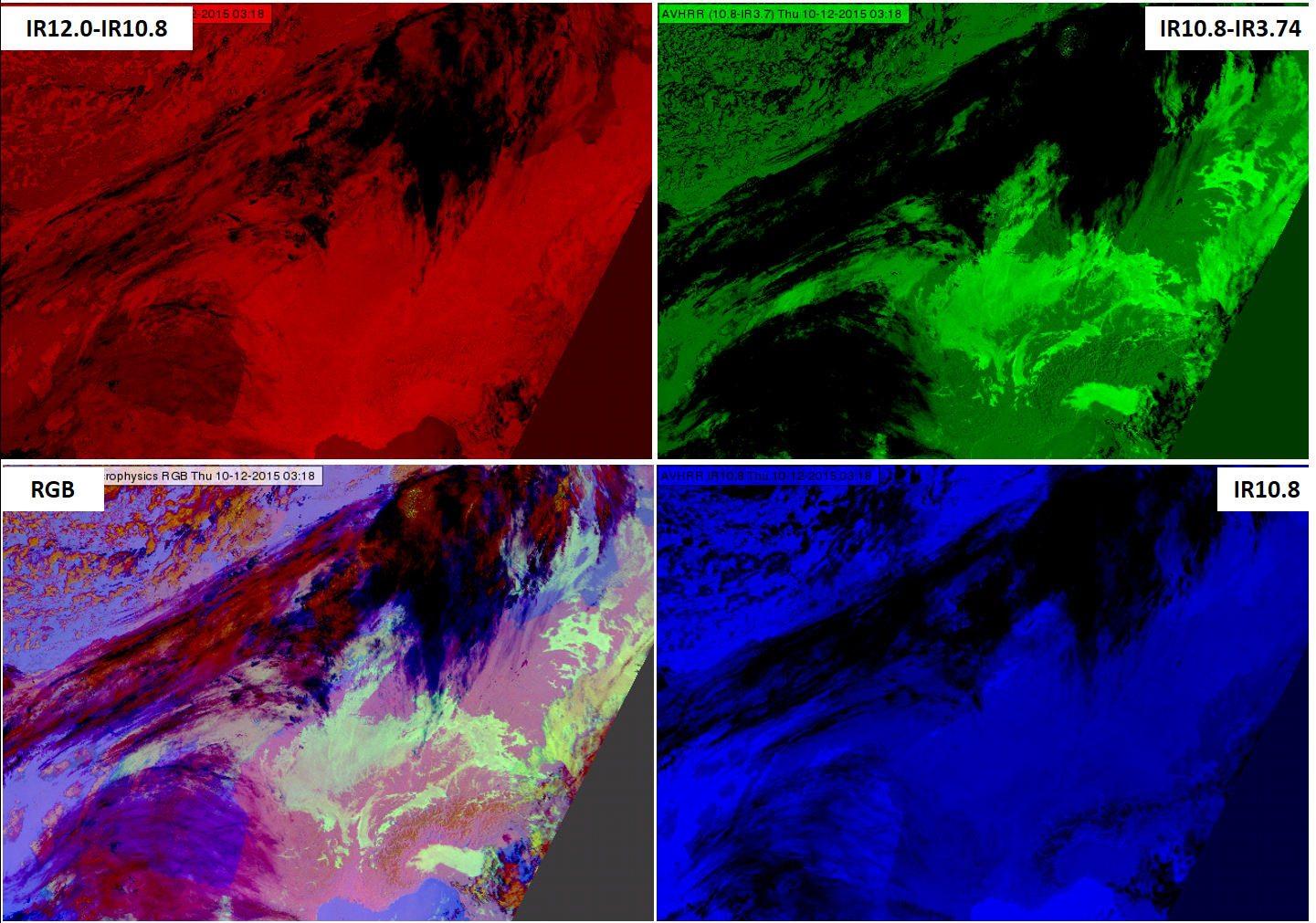
_20151210_0318.png)
_20151210_0318.png)
